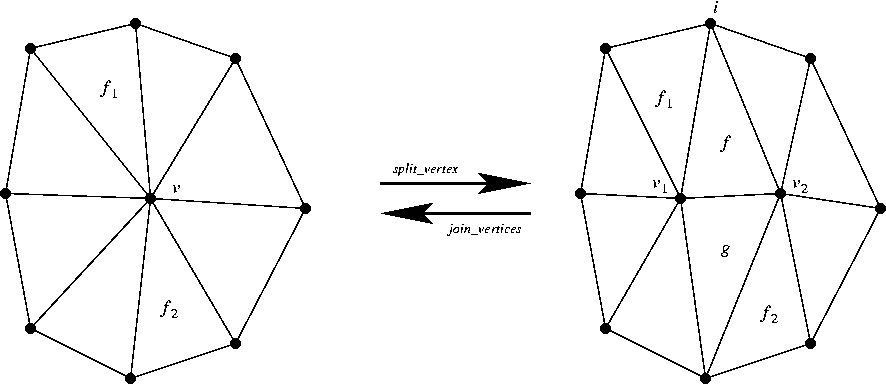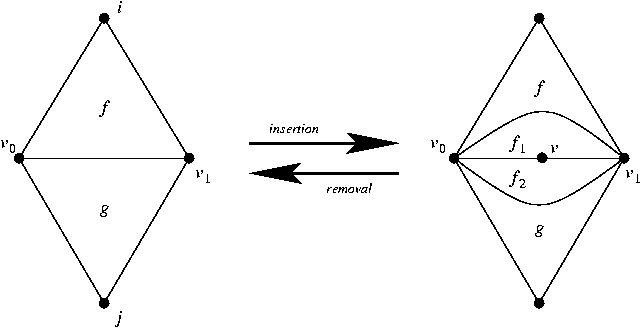|
CGAL 4.9.1 - 2D Triangulation Data Structure
|
|
CGAL 4.9.1 - 2D Triangulation Data Structure
|
#include <CGAL/Triangulation_data_structure_2.h>
The class Triangulation_data_structure_2 is a model for the TriangulationDataStructure_2 concept.
It can be used to represent an orientable 2D triangulation embedded in a space of any dimension.
The vertices and faces are stored in two nested containers, which are implemented using Compact_container. The class may offer some flexibility for the choice of container in the future, in the form of additional template parameters.
Modifiers
In addition to the modifiers required by the TriangulationDataStructure_2 concept, the Triangulation_data_structure_2 class supports also the modifiers below. Note also that the modifiers below guarantee the combinatorial validity of the resulting data structure.
Illustrations


Types | |
|
typedef Triangulation_data_structure_2 < Vb, Fb > | Tds |
|
typedef Vb::template Rebind_TDS< Tds >::Other | Vertex |
| The vertex type. | |
|
typedef Fb::template Rebind_TDS< Tds >::Other | Face |
| The face type. | |
Advanced In addition to the interface documented in the concept, the class offers the following types. | |
| typedef Compact_container< Vertex > | Vertex_range |
| Vertex container type. | |
| typedef Compact_container< Face > | Face_range |
| Face container type. | |
Operations | |
Advanced In addition to the interface documented in the concept, the class offers the following functions. | |
| Face_range & | faces () const |
| Returns a reference to the container of faces. | |
| Face_range & | faces () |
| Returns a reference to the container of faces. | |
| Vertex_range & | vertices () const |
| Returns a reference to the container of vertices. | |
| Vertex_range & | vertices () |
| Returns a reference to the container of vertices. | |
Modifiers | |
| Vertex_handle | join_vertices (Face_handle f, int i) |
Joins the vertices that are endpoints of the edge (f,i), and returns a vertex handle to common vertex (see Fig. figtdssplitjoin). More... | |
| Vertex_handle | join_vertices (Edge e) |
Joins the vertices that are endpoints of the edge e, and returns a vertex handle to common vertex. | |
| Vertex_handle | join_vertices (Edge_iterator eit) |
Joins the vertices that are endpoints of the edge *eit, and returns a vertex handle to common vertex. | |
| Vertex_handle | join_vertices (Edges_circulator ec) |
Joins the vertices that are endpoints of the edge *ec, and returns a vertex handle to common vertex. | |
| boost::tuples::tuple < Vertex_handle, Vertex_handle, Face_handle, Face_handle > | split_vertex (Vertex_handle v, Face_handle f1, Face_handle f2) |
Splits the vertex v into two vertices v1 and v2. More... | |
| Vertex_handle | insert_degree_2 (Face_handle f, int i) |
| Inserts a degree two vertex and two faces adjacent to it that have two common edges. More... | |
| void | remove_degree_2 (Vertex_handle v) |
| Removes a degree 2 vertex and the two faces adjacent to it. More... | |
| Vertex_handle CGAL::Triangulation_data_structure_2< Vb, Fb >::insert_degree_2 | ( | Face_handle | f, |
| int | i | ||
| ) |
Inserts a degree two vertex and two faces adjacent to it that have two common edges.
The edge defined by the face handle f and the integer i is duplicated. It returns a handle to the vertex created (see Fig. figtdsirdeg2).
| Vertex_handle CGAL::Triangulation_data_structure_2< Vb, Fb >::join_vertices | ( | Face_handle | f, |
| int | i | ||
| ) |
Joins the vertices that are endpoints of the edge (f,i), and returns a vertex handle to common vertex (see Fig. figtdssplitjoin).
f must be different from Face_handle() and i must be 0, 1 or 2. | void CGAL::Triangulation_data_structure_2< Vb, Fb >::remove_degree_2 | ( | Vertex_handle | v) |
Removes a degree 2 vertex and the two faces adjacent to it.
The two edges of the star of v that are not incident to it are collapsed (see Fig. figtdsirdeg2).
v must be equal to 2. | boost::tuples::tuple<Vertex_handle, Vertex_handle, Face_handle, Face_handle> CGAL::Triangulation_data_structure_2< Vb, Fb >::split_vertex | ( | Vertex_handle | v, |
| Face_handle | f1, | ||
| Face_handle | f2 | ||
| ) |
Splits the vertex v into two vertices v1 and v2.
The common faces f and g of v1 and v2 are created after (in the counter-clockwise sense) the faces f1 and f2. The 4-tuple (v1,v2,f,g) is returned (see Fig. figtdssplitjoin).
dimension() must be equal to 2, f1 and f2 must be different from Face_handle() and v must be a vertex of both f1 and f2.